

































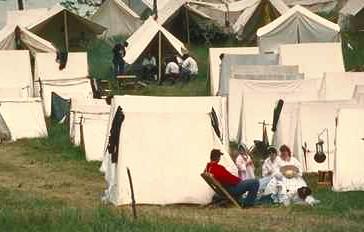 There are two possible scenarios for the beginning of hard times:
There are two possible scenarios for the beginning of hard times: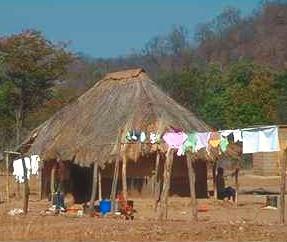 Is a worldwide famine in your future? I don't know. But I do pay attention to the news and I do know that the United States of America is having serious planting problems with millions and millions of acres of their agricultural land in the Spring of the year 2011. And many of the other major food exporting countries around the world are also experiencing severe planting and/or harvesting problems this year. And many, many news commentators are now predicting a significant increase in food prices later this year. If food prices significantly increase at the same time that tax revenues are down and the true unemployment rate is exceptionally high, then this combination of events could easily lead to massive worldwide unrest due to a simple ordinary worldwide famine. If this happens then living conditions will be leveled worldwide and everyone everywhere will be living in a nightmare third-world economy. The reason is because politicians and governments can't simply create food by passing new laws or making long speeches. All they can do is try to deceive people into believing that they have everything under control and that the horrible growling noise that everyone is hearing from their stomachs is just their imagination playing tricks on them. This is the one speech that nobody is going to believe and when that happens then the people of the world will revolt in a most unpleasant fashion.
Is a worldwide famine in your future? I don't know. But I do pay attention to the news and I do know that the United States of America is having serious planting problems with millions and millions of acres of their agricultural land in the Spring of the year 2011. And many of the other major food exporting countries around the world are also experiencing severe planting and/or harvesting problems this year. And many, many news commentators are now predicting a significant increase in food prices later this year. If food prices significantly increase at the same time that tax revenues are down and the true unemployment rate is exceptionally high, then this combination of events could easily lead to massive worldwide unrest due to a simple ordinary worldwide famine. If this happens then living conditions will be leveled worldwide and everyone everywhere will be living in a nightmare third-world economy. The reason is because politicians and governments can't simply create food by passing new laws or making long speeches. All they can do is try to deceive people into believing that they have everything under control and that the horrible growling noise that everyone is hearing from their stomachs is just their imagination playing tricks on them. This is the one speech that nobody is going to believe and when that happens then the people of the world will revolt in a most unpleasant fashion.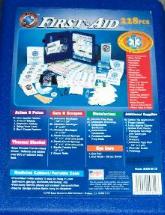



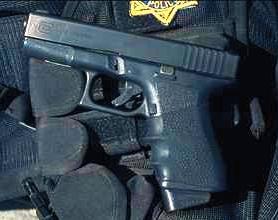 Handgun: I strongly recommend a semi-automatic pistol instead of a revolver or a single-shot handgun. My first choice in a handgun would be a Glock Model 22 with a 15-round magazine that shoots the 40 caliber bullet. This is the same handgun that the overwhelming vast majority of law enforcement officers in the United States select as their primary sidearm. These men and women are intelligent individuals and they know that their lives may occasionally depend on their handgun selection. The Glock handgun is an exceptionally high quality firearm, it is very reliable, and the 40 caliber bullet has an impressive law enforcement history of being an effective man-stopper. The 40 caliber bullet (40 S&W) generates a reasonable and controllable amount of recoil so it is also an accurate firearm. My second choice in a handgun would be a Glock Model 21SF (SF = Slim Frame) with a 13-round magazine that shoots the 45 caliber bullet (45 ACP or 45 Auto but not the 45 GAP). The 45 caliber bullet also has an impressive law enforcement history that is almost identical to the 40 caliber bullet. However, the grip of the Model 21SF is 1/4 inch greater in circumference than the Model 22 and this makes it more challenging for a person with a smaller hand to comfortably grasp. The recoil of the 45 caliber bullet is also more than the 40 caliber bullet and this makes it more challenging for many individuals to shoot accurately. One very important consideration in the selection of a handgun is that it should feel comfortable in your hand when you hold it. Finally, if you are the only person in your family who can comfortably grip and shoot a 45 pistol, and you should become incapacitated for any reason, then nobody else in your family would be able to use your 45 for effective defense or protection. Regardless of which Glock model you purchase you should also install an internal laser sight made by LaserMax. You should also invest in a holster that contains a spare magazine compartment at the front of the holster. Finally, if you can afford it, you should invest in 1,000 rounds of ammunition for your handgun.
Handgun: I strongly recommend a semi-automatic pistol instead of a revolver or a single-shot handgun. My first choice in a handgun would be a Glock Model 22 with a 15-round magazine that shoots the 40 caliber bullet. This is the same handgun that the overwhelming vast majority of law enforcement officers in the United States select as their primary sidearm. These men and women are intelligent individuals and they know that their lives may occasionally depend on their handgun selection. The Glock handgun is an exceptionally high quality firearm, it is very reliable, and the 40 caliber bullet has an impressive law enforcement history of being an effective man-stopper. The 40 caliber bullet (40 S&W) generates a reasonable and controllable amount of recoil so it is also an accurate firearm. My second choice in a handgun would be a Glock Model 21SF (SF = Slim Frame) with a 13-round magazine that shoots the 45 caliber bullet (45 ACP or 45 Auto but not the 45 GAP). The 45 caliber bullet also has an impressive law enforcement history that is almost identical to the 40 caliber bullet. However, the grip of the Model 21SF is 1/4 inch greater in circumference than the Model 22 and this makes it more challenging for a person with a smaller hand to comfortably grasp. The recoil of the 45 caliber bullet is also more than the 40 caliber bullet and this makes it more challenging for many individuals to shoot accurately. One very important consideration in the selection of a handgun is that it should feel comfortable in your hand when you hold it. Finally, if you are the only person in your family who can comfortably grip and shoot a 45 pistol, and you should become incapacitated for any reason, then nobody else in your family would be able to use your 45 for effective defense or protection. Regardless of which Glock model you purchase you should also install an internal laser sight made by LaserMax. You should also invest in a holster that contains a spare magazine compartment at the front of the holster. Finally, if you can afford it, you should invest in 1,000 rounds of ammunition for your handgun.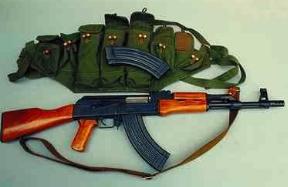 Rifle for Hunting and Self-Defense: I strongly recommend a semi-automatic rifle instead of a bolt-action rifle or a lever-action rifle. My first choice in a rifle would depend on where I lived. If I lived in an area where the vast majority of my shooting would be done in areas where the normal visibility was 200 yards or less then I would invest in an original design AK-47 that shoots the 7.62x39 bullet. This bullet has a normal average trajectory of plus 1.5 inches at 110 yards and minus 1.5 inches at 175 yards (3 inch total circle) and it is lethal out to 240 yards. If I lived in an area where the vast majority of my shooting would be done in areas where the normal visibility was more than 200 yards then I would invest in an AR-10 that shoots the 7.62x51 bullet (308 caliber). This bullet has a normal average trajectory of plus 3 inches at 125 yards and minus 3 inches at 260 yards (6 inch total circle) and it is lethal out to 600 yards. I strongly recommend that you add a sling and a good scope to your rifle using see-through scope mounts. The scope mount has a significant impact on the stability and reliability of your scope so I recommend a mount that has four screws on each mount that holds the scope to the mount (total of eight mounting screws on both mounts). You can buy good scopes for less than $100. If you can afford it then you can spend more on a scope but my opinion is that most people will find that a scope that cost between $40 to $100 will perform very well for all their shooting. Finally, if you can afford it, you should invest in 1,000 rounds of ammunition for your rifle. (Note: If possible, purchase an AK-47 with a folding rear stock instead of a wood stock, and a black plastic front hand grip instead of a wood front hand grip. The folding rear stock should fold over against the side of the rifle.)
Rifle for Hunting and Self-Defense: I strongly recommend a semi-automatic rifle instead of a bolt-action rifle or a lever-action rifle. My first choice in a rifle would depend on where I lived. If I lived in an area where the vast majority of my shooting would be done in areas where the normal visibility was 200 yards or less then I would invest in an original design AK-47 that shoots the 7.62x39 bullet. This bullet has a normal average trajectory of plus 1.5 inches at 110 yards and minus 1.5 inches at 175 yards (3 inch total circle) and it is lethal out to 240 yards. If I lived in an area where the vast majority of my shooting would be done in areas where the normal visibility was more than 200 yards then I would invest in an AR-10 that shoots the 7.62x51 bullet (308 caliber). This bullet has a normal average trajectory of plus 3 inches at 125 yards and minus 3 inches at 260 yards (6 inch total circle) and it is lethal out to 600 yards. I strongly recommend that you add a sling and a good scope to your rifle using see-through scope mounts. The scope mount has a significant impact on the stability and reliability of your scope so I recommend a mount that has four screws on each mount that holds the scope to the mount (total of eight mounting screws on both mounts). You can buy good scopes for less than $100. If you can afford it then you can spend more on a scope but my opinion is that most people will find that a scope that cost between $40 to $100 will perform very well for all their shooting. Finally, if you can afford it, you should invest in 1,000 rounds of ammunition for your rifle. (Note: If possible, purchase an AK-47 with a folding rear stock instead of a wood stock, and a black plastic front hand grip instead of a wood front hand grip. The folding rear stock should fold over against the side of the rifle.) 22 Caliber Semi-Automatic Rifle: If you can afford it then my first choice in a 22 rifle would be the Ruger Model 10/22 with detachable 10-round magazine. If you can afford it then purchase a 10/22 with a stainless steel barrel rifle. My second choice in a 22 rifle would be the very affordable Savage Arms Model 64F semi-automatic rifle with detachable 10-round magazine. Regardless of your rifle choice buy some extra magazines. Install a sling and a reasonable quality scope ($30 to $60) on your rifle using see-through scope mounts. If you can afford it, purchase 5,000 rounds of 22LR ammunition for your rifle.
22 Caliber Semi-Automatic Rifle: If you can afford it then my first choice in a 22 rifle would be the Ruger Model 10/22 with detachable 10-round magazine. If you can afford it then purchase a 10/22 with a stainless steel barrel rifle. My second choice in a 22 rifle would be the very affordable Savage Arms Model 64F semi-automatic rifle with detachable 10-round magazine. Regardless of your rifle choice buy some extra magazines. Install a sling and a reasonable quality scope ($30 to $60) on your rifle using see-through scope mounts. If you can afford it, purchase 5,000 rounds of 22LR ammunition for your rifle. Concealed Carry: My first choice for a concealed carry handgun would be the Ruger LCP that fires the 380 ammunition. I strongly suggest that you install a Crimson Trace laser sight on this pistol. The laser sight is automatically activated when you grip the pistol in your hand. If you purchase the Crimson Trace laser it will include a nice carrying pouch that can be used to transport the Ruger LCP in your pocket. The reasons I suggest this specific pistol are: it is an exceptionally high quality very reliable semi-automatic 6-shot pistol, it is relatively flat (less than 3/4-inch) which means it can fit into your pants' pocket without creating the normal silhouette outline of a gun, it is very light weight even when fully loaded (12 ounces), and it fires a 380 caliber bullet which is very similar to the 9mm bullet. I also recommend that you install the finger extension on the bottom of the 6-round magazine to make the pistol more comfortable to grip and to shoot accurately. Also purchase at least 500 rounds of hollow-point ammunition for this pistol.
Concealed Carry: My first choice for a concealed carry handgun would be the Ruger LCP that fires the 380 ammunition. I strongly suggest that you install a Crimson Trace laser sight on this pistol. The laser sight is automatically activated when you grip the pistol in your hand. If you purchase the Crimson Trace laser it will include a nice carrying pouch that can be used to transport the Ruger LCP in your pocket. The reasons I suggest this specific pistol are: it is an exceptionally high quality very reliable semi-automatic 6-shot pistol, it is relatively flat (less than 3/4-inch) which means it can fit into your pants' pocket without creating the normal silhouette outline of a gun, it is very light weight even when fully loaded (12 ounces), and it fires a 380 caliber bullet which is very similar to the 9mm bullet. I also recommend that you install the finger extension on the bottom of the 6-round magazine to make the pistol more comfortable to grip and to shoot accurately. Also purchase at least 500 rounds of hollow-point ammunition for this pistol.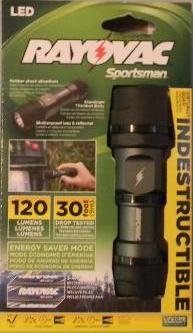 On the other hand, a flashlight has the following advantages:
On the other hand, a flashlight has the following advantages: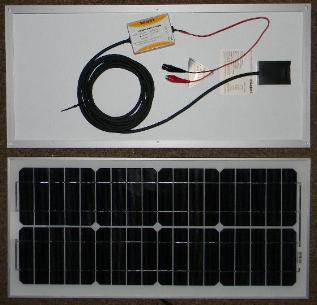
| 
| 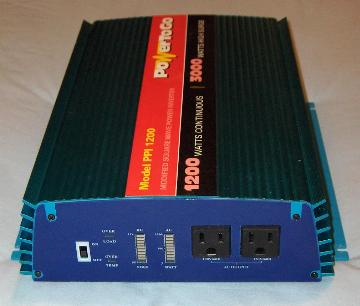
|
| Two 15 Watt Solar Panels "Instapark Monocrystalline" Top = Back of Panel with Controller Bottom = Front of Panel |
12 Volt Adapter with Three 12-Volt Outlets and Red and Black Wires |
1,200 Watt Inverter with On/Off Switch and Two Power Meters and Two 110-Volt Outlets |
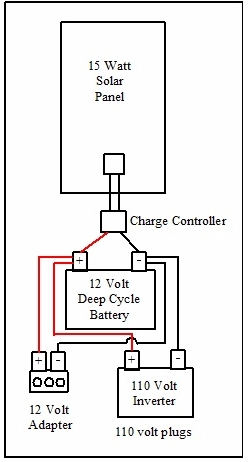 Connect the two color-coded alligator clips from the solar panel to the positive (red wire) and negative (black wire) terminals of the battery. Connect the two color-coded wires from the 12-volt adapter to the battery. Connect the 110-volt inverter to the battery using some of the 12-gauge electrical wire.
Connect the two color-coded alligator clips from the solar panel to the positive (red wire) and negative (black wire) terminals of the battery. Connect the two color-coded wires from the 12-volt adapter to the battery. Connect the 110-volt inverter to the battery using some of the 12-gauge electrical wire.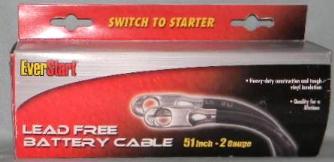
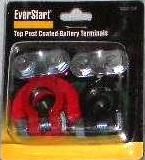 Wire Sizes: Generally the larger the wire size the more efficient your solar generator will be. If the electrical openings in your solar generator equipment will allow you to use 12-gauge wire then you should do so. However, some of the components may have smaller openings and they may require 14-gauge or 16-gauge wire. Therefore read the instructions that come with your solar equipment before you purchase your wire. The one exception is if you have more than one 12-volt battery. You should connect your batteries together using standard automobile 2-gauge cable. Depending on where you intend to put your 12-volt batteries you may need to position them either side-by-side or end-to-end with at least 1/4-inch of air space between the batteries. After you have your batteries positioned then you could cut your battery cables to the optimum length so you have a slight bend in the wire between batteries. A battery cable may be cut with a metal saw or a hacksaw or a jig-saw. One way to do this inexpensively is to buy the longest 2-gauge battery wire you can find (or 0-gauge battery wire), and then cut it to the lengths you need, and then install a battery connector clamp on the bare end of the battery wire that you just cut. These are the same type of battery connectors that are used on your automobile battery and you can find them in the automotive section of most stores. The clamp connectors in the illustration have a red clamp for the positive terminal and a black clamp for the negative terminal. Or you can purchase the solid brass clamps.
Wire Sizes: Generally the larger the wire size the more efficient your solar generator will be. If the electrical openings in your solar generator equipment will allow you to use 12-gauge wire then you should do so. However, some of the components may have smaller openings and they may require 14-gauge or 16-gauge wire. Therefore read the instructions that come with your solar equipment before you purchase your wire. The one exception is if you have more than one 12-volt battery. You should connect your batteries together using standard automobile 2-gauge cable. Depending on where you intend to put your 12-volt batteries you may need to position them either side-by-side or end-to-end with at least 1/4-inch of air space between the batteries. After you have your batteries positioned then you could cut your battery cables to the optimum length so you have a slight bend in the wire between batteries. A battery cable may be cut with a metal saw or a hacksaw or a jig-saw. One way to do this inexpensively is to buy the longest 2-gauge battery wire you can find (or 0-gauge battery wire), and then cut it to the lengths you need, and then install a battery connector clamp on the bare end of the battery wire that you just cut. These are the same type of battery connectors that are used on your automobile battery and you can find them in the automotive section of most stores. The clamp connectors in the illustration have a red clamp for the positive terminal and a black clamp for the negative terminal. Or you can purchase the solid brass clamps.
